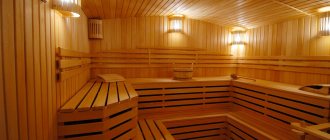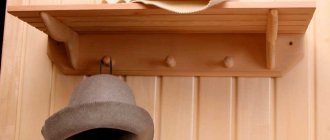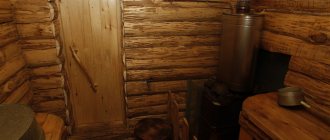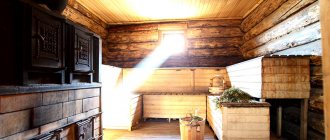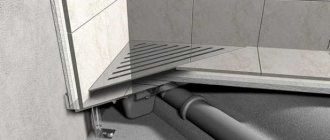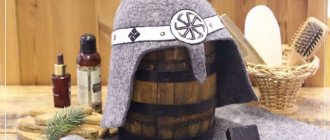Prevention work at the stage of laying and building a bathhouse
The most effective protection against fungus is carried out at the design and construction stage. Recommendations for preventing mold growth:
- It is important to use wood cut in winter. It is recommended to lay the foundation in frosty weather, and build the walls and roof in the spring.
- Before starting work, it is necessary to study the wood. If there are traces of fungus on at least one of the logs, it is better to set aside the entire batch and replace it with a new one . There is a special device that allows you to measure humidity levels. It helps select dry wood for construction.
- When designing or drawing up a drawing, it is important to think through and note the location of the holes for natural ventilation. They should be under the floors in the crawl space, in the attic, in the ribs of the frame.
- Before erecting walls, it is necessary to consider waterproofing the foundation. It is recommended to protect all supporting structures with a vapor barrier.
- You should not save on buying a powerful hood or antiseptics.
- Freezing walls, slopes, and ceilings need to be insulated and ventilation valves installed in plastic windows.
What can you do if a fungus appears in a bathhouse during its operation?
Recommendations for preventing the emergence of new lesions:
- It is necessary to eliminate leaks in plumbing and pipes.
- It is necessary to check the sources of forced and natural ventilation.
- If the bathhouse is heated constantly, you must always maintain a high temperature inside.
- After turning off the heating, it is necessary to remove wet rags outside: towels, rugs that lie on the floor, benches. Screens and textiles must be carefully straightened so that they dry.
- The fungus actively reproduces on dirty surfaces, so the interior must be washed after each visit with water using products intended for the hygiene of baths and saunas.
Price of means for removing fungus in a bath
Many owners decide how to treat fungus in a bathhouse, based on the price of the product and method used. Mechanical processing with all the tools will be the most cost-effective. Impregnation with folk remedies is a little more expensive. The price of store-bought antiseptics is ambiguous. It all depends on the popularity of the manufacturer’s brand, but in most cases it is high. There are a lot of options for how to destroy mold - you should choose the one that is acceptable to you.
Find out how vapor barrier is carried out for the walls of a wooden house.
How to deal with a fungal colony
Mold most often appears in wooden baths, which are heated not constantly, but from time to time. Fungal colonies have no special preferences. They settle on walls, floors, ceilings, where there is the most dampness . If the room is not insulated enough, a white mushroom appears on the tree (see photo).
You can fight a fungal colony:
- mechanically,
- chemicals,
- folk remedies.
Mechanical way of fighting
The method involves manually rubbing the affected area using a spatula, iron brush, or sandpaper. You can use a grinder or drill equipped with a brush attachment.
When performing mechanical cleaning, you need to look at how deep the fungus has penetrated into the soft texture. You can make a replacement. To do this, you need to cut out the affected area in the timber and insert a new fragment in its place.
Before cleaning the boards, the base must be thoroughly watered. Humidity will prevent the spread of pests.
How to treat a bathhouse for mold
There are many products that help kill mold. They can be purchased in the store in the form of a ready-made solution, or you can make them yourself. It is better to buy antiseptics for superficial and deep use from well-known and trusted brands that guarantee protection of the boards and a positive result in eliminating mold. This is for example:
- Biotol;
- Metas-Bio;
- Ceresite;
- Dali;
- Neomid-Bio;
- Earlene;
- Pentatos.
Among the folk remedies that can be used to remove fungus in a bathhouse, choose:
- Bleach, which consists of quicklime bleach and plain water. It is applied to a dry surface.
- Copper sulfate: It is sold everywhere in stores that specialize in gardening. If you make a solution per liter of water, then you need to take fifty grams of vitriol, one hundred grams of potassium alum and thirty grams of table salt.
- Sulfur, the price of which is low, and the result is fast and ideal. A sulfur block is ignited in a fireproof container (basin, bucket), which during combustion releases gas, destroying fungal spores throughout the room.
- Hydrogen peroxide at 20-25% is applied to the wood and left for several hours, and then wiped with a rag soaked in water.
- Regular white, which can be bought at an affordable price in hardware stores. After applying this substance, the walls should be additionally treated with water.
Mechanical surface cleaning
If the depth of penetration of the fungus is not very significant, then you can use mechanical cleaning of the affected area. For this, construction tools and devices will be useful: a spatula, sandpaper, a metal brush, a grinding machine. After visible areas of mold have been removed, it is advisable to incinerate the waste to prevent the development of fungus on other objects. Mechanical cleaning is also used when mold penetrates deeply, cutting out a piece of wood and inserting new material there.
Treating wood against fungus with folk remedies
How to remove fungus in a bathhouse? The best help is from folk remedies that have been tested by more than one generation. Chloride of lime, copper sulfate, sulfur bomb, hydrogen peroxide and household bleach work well against fungus and are low in price. When using these compositions, you should follow the preparation instructions, and also wear a protective mask to prevent vapors of harmful substances from entering the body. In the case of a sulfur bomb, you must leave the room and close the windows, doors and all cracks tightly.
Antiseptic agents for mold
In addition to mechanically getting rid of fungus or using folk remedies, it is recommended to purchase professional preparations. Store-bought surface- and deep-penetration antiseptics, which are completely different in price, will do an excellent job of removing mold. How to remove fungus in a bathhouse for a long time? It is better to choose products from trusted manufacturers, such as Biotol, Metas-Bio, Ceresit, Dali, Neomid-Bio, because the chemistry of little-known companies may not help, and the money will be wasted.
Chemicals
Chemical compounds must be used carefully. Some of them are absorbed into the wood. When walls, ceilings, and floors are heated, dangerous toxins are released into the air. It is necessary to choose deep penetration antiseptics intended for treating walls, ceilings, and floors of saunas and baths.
Products are divided into three groups: organic, oil-based, combined, and water-based antiseptics. The first two are highly toxic. Water-based septic tanks are designed for treating internal surfaces of premises, including baths. Processing must be done using protective equipment.
When choosing a composition, you must give preference to proven brands - Scandinavian and German brands.
Causes
The main cause of mold growth in a bathhouse is humid air. Humidity accumulates due to improper ventilation, so first of all pay attention to the air ventilation system.
If the weather has not been pleasant for several days, it has been raining or snowing, you may notice small black dots appearing on the tree. In this case, the problem lies in the construction process.
Most likely, during the construction of the bathhouse, the walls were incorrectly insulated or the roof was installed incorrectly. Moisture can get into the wood. If black spots appear inside, then they are also outside the room.
The next reason for the growth of fungus is condensation. The evaporation of moisture into the room increases the humidity level, which means ideal conditions are created for the proliferation of new mold colonies.
Leaking water from pipes also causes this problem. Especially if the leak is inside the wall and cannot be seen unless you conduct investigations throughout the room.
Mold will appear if there is a basement under the sauna. Usually such rooms are damp, the level is higher than in other rooms. If the basement is poorly ventilated and is also cold, this leads to the formation of condensation not only in it, but also in the rooms nearby.
Where do the dark spots on the lining come from?
There is a whole list of reasons for the darkening of wood paneling in a steam room:
- normal pollution;
- ingress of tannins, which are contained in large quantities in brooms - stains from them are of almost the same nature as deposits from strong brewed tea;
- soot or soot from burning wood;
- white, brown, bacterial mold (leads to wood rotting from the inside);
- black fungus (usually appears on the surface in the form of a dark “spray”);
- blue fungi (manifest as a gray-blue coating on the surface).
boriemsia-s-ghribkom-i-pliesieniu-na-dachie_2.jpg
In the first two cases, removing stains will not be difficult at all - they are superficial and can be easily erased with laundry soap, soda, salt or mustard powder mixed with lemon juice dissolved in water. You should not use chemical detergents to avoid inhaling their vapors during subsequent bath procedures.
voshchenie.jpg
Complex stains, as well as blackening from soot, can be cleaned with an abrasive - sandpaper or a grinding machine. It is better to choose a circle of small diameter (12-13 cm), and a nozzle with a grain size of up to 35 units. After finishing work, you must thoroughly vacuum the room and wash off any remaining dust with a damp sponge or cloth.
shlifovka-sten1.jpg
Harm from mold
The appearance of such a phenomenon as mold in a bathhouse can be harmful to health. The fungus itself, which occurs due to humidity, does not become dangerous; the spores formed in it are harmful. The entry of these particles into the human body through breathing provokes many negative conditions. Serious diseases include:
- skin pathologies – mycoses or acute dermatoses;
- damage to the respiratory system, which can lead to chronic cough and runny nose;
- diseases of the musculoskeletal system;
- development of joint diseases;
- frequent headaches, lethargy;
- allergic reaction.
Why is fungus dangerous?
Mold spores are not dangerous as long as they are inactive. They are activated due to dampness: condensation and stagnant moisture. Molds produce mycotoxins that cause various diseases. A healthy body will not react immediately to the harm of mold, but later problems will definitely appear. For a person with a weakened immune system, mold can serve as a catalyst for exacerbation of diseases.
Spores enter the body through the air and through the skin. They cause the following ailments:
- allergy;
- respiratory diseases (bronchitis, pneumonia, asthma);
- skin problems - dermatitis and eczema.
If the mold has managed to grow, a person can become intoxicated.
Environmental factors
Due to the peculiarities of operation, the interior of the bathhouse systematically heats up and cools sharply, while it is affected either by hot steam or drops of condensate. In such conditions, even concrete and brick quickly collapse, let alone porous wood. As a rule, the main reason for the darkening of the lining in this room is poor ventilation and insufficient drying of the walls, sun loungers and floors after each use. Another common mistake is the use of boards that were not initially treated with protective compounds. They are the ones that are most quickly susceptible to fungal infection, and within a year or two they may require restoration.
_5r4wdalkey.jpg
If we are talking about plank upholstery located close to the stove and chimney, then its blackening is usually caused by charring or smoke. Such signs should never be ignored, otherwise a fire may soon start in this place. The correct solution in this situation would be to completely remove the easily flammable elements along the wall with the stove, replacing them with fireclay bricks, tiles or other fire-resistant material, and lay a fairly wide metal sheet on the floor.
gto25gaf.jpg
bannaya-pech.jpg
Microwave drying
Although the best result in the fight against the parasite is shown by microwave drying, which ours uses. If there is mold in the bathhouse, let’s take a closer look at how to get rid of it using this unique method.
How does it work
The operating principle of the device is based on the influence of millimeter and centimeter frequencies on the fungus, which heat the area where the mold spreads.
Since a sufficiently high temperature is not suitable for the life of the fungus, it is understandable why, after such exposure, it dies simultaneously with its spores. The microwave method removes mold in any damp structure very quickly and effectively. Properly carried out sanitary disinfection makes it possible to destroy almost 99% of the entire area of infection. Using radiation, it is possible to influence pathogenic microorganisms in any structure of the material deeply enough (up to 35 cm), which makes it possible to completely destroy the mycelium that is not located on the upper planes. The special device used is equipped with a built-in laser pyrometer, which allows extremely fine adjustment of heating, thereby monitoring the thermal treatment of affected surfaces.
What are the advantages
- fast processing is ensured, since it takes significantly less time to destroy mold on any surface than when using other methods;
- the need to come into contact with any chemicals, often hazardous to human health, is completely eliminated;
- due to the possibility of heat penetration into the structure of the damaged material, processing hard-to-reach places, work efficiency increases;
- correct use of the technique allows you to easily destroy almost 99 percent of the fungal spores that parasitize on the surface of the walls;
- the positive result does not depend on the material of the surface being treated - the effectiveness is the same for plastic and wood, paper and cardboard, in which mold likes to grow;
- guaranteed safety in relation to humans, due to which there is no need to use specific protective equipment.
Cleaning the tank
Due to the hardness of tap water, the question periodically arises of how to clean the tank in a bathhouse from scale that settles on the walls and bottom. Since scale is formed from lime deposits, it must be cleaned with acid.
Acid can only be used of organic origin. For example, lemon or vinegar. Any inorganic acid is unsafe for the metal from which the tank is made. It should be remembered that the amount of acid used to clean the tank should approximately correspond in weight to the amount of lime deposits on the walls of the heating tank.
On a note! Installing a special filter at the inlet will help prevent the formation of large amounts of scale.
The water passing through it will be purified from a significant amount of impurities. This will greatly reduce the level of scale formation.
Basic Rules
How to clean soot in a bath? There are certain rules for this. For example, wooden surfaces covered with a layer of soot should not be wetted.
Wood is a hygroscopic material that quickly absorbs moisture. Together with water, everything that has settled on the surface - soot, soot, bodily fluids, etc. - will be absorbed into the structure of wooden elements. Once the dirt is absorbed into the surface of the wood, it will be almost impossible to clean the shelves in the bathhouse, walls, floor or ceiling.
Therefore, when deciding how to clean soot from walls or floors in a bathhouse, you should categorically refuse to use such substances and materials as:
- laundry soap;
- water;
- sponges;
- spray guns.
All of the above products can only be used for final cleaning of wooden surfaces, when the carbon deposits have already been cleaned dry.
All work on cleaning the bathhouse from soot and soot must be carried out using special protective equipment:
- blind safety glasses;
- respirator;
- thick rubber gloves.
All this will help prevent combustion products from entering the respiratory tract.
